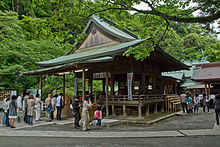Kamakura-gū
The Kamakura-gū ( Japanese 鎌倉 宮 ) is a Shinto shrine in the east of the city of Kamakura , Kanagawa Prefecture , Japan. It is not to be confused with the much better known Tsurugaoka Hachiman-gū . The Kamakura-gū is also known under the name Ōtōnomiya or Daitōnomiya ( Japanese 大 塔 宮 ).
history
The shrine was built by Tennō Meiji in 1869. In the Kamakura-gu, the Kami of Prince Ōtōnomiya Morinaga (1308-1336) is inscribed. He was arrested in 1335 and executed nine months later on the site where the shrine stands today, on the orders of Ashikaga Tadayoshi .
Up until his execution, Prince Morinaga was locked in a cave for nine months, which is now part of the shrine grounds and an attraction of the shrine. The cave is 4 m carved into the stone and has a size of about 12 square meters. (It is more likely, however, that Morinaga was under house arrest and not locked in the cave.)
The site was owned by Tokeiji Temple before the shrine was built. After Morinaga's execution was announced, one of his sisters went to the temple in mourning and became a nun. It is believed that she was the 25th main nun of the temple under the name Yodo-ni. The temple gave the area to the Tennō Meiji on condition that a shrine be built.
Nowadays the shrine is very popular as a visit is meant to ward off bad luck and evil. One can pray for it and acquire a talisman called Shishi-Gashira.
There are two major festivities every year: a Nō performance on October 8th and 9th and the New Year's cleansing ritual on the first 5 days after the New Year. During these 5 days, access to the Haiden is possible to take part in the ritual , which is closed to normal visitors for the rest of the year.
The shrine area
At the entrance to the shrine there is a white torii and the house for the tickets. (You have to pay 300 yen before you are allowed into the shrine area.) From here, steps lead directly in front of the Haiden . Behind the Haiden is the Honden , in which the shrines are kept and which is not open to the public.
If you go left past Haiden and Honden you will reach the back of the shrine area, where the cave is located. Here on the left side there is a sub-cabinet dedicated to the lady-in-waiting Minami-no-kata. She was pregnant with his son at the time of Morinaga's death. The fatherless son was placed in a monastery of the Nichiren sect and became known as Nichiei . The sub-shrine was not built until 2004.
At the back of the Honden is the cave in which Morinaga was, according to tradition, imprisoned for nine months. The entrance to the cave is blocked by a wooden gate.
The path leads past the cave through a forest, past a monument and back to the forecourt. Shortly before the exit there is a small building in which other treasures from the shrine are exhibited.
To the right of the Haiden is another sub-cabinet. It is dedicated to Yoshiteru Murakami (? –1333), who sacrificed his life in a battle near Osaka to save Prince Morinaga by standing in the way of the attackers as a human shield. In his honor there is a small memorial ceremony every year on August 20th.
Shishi Gashira
The Shishi-Gashira is a wooden tablet with a lion's head. It is considered a talisman against misfortune and evil. According to legend, Prince Morinaga wore such a talisman during his battles. Such a talisman can be purchased in the shrine. In front of the Haiden there is also a wooden lion head with an open mouth. He should eat the bad.
Takigi Nō
Annually on October 8th and 9th, Nō performances take place. The performance starts at 7 p.m. and lasts about 2 hours. These performances used to take place in September, but were often canceled due to bad weather, so the decision was made to move them to October.
For the performance, the electric lighting is switched off and the place is only lit by a wood fire. This type of performance is called Takigi Nō (wood fire Nō). The origin of this Nō-kind is at the temple Kōfuku-ji in the prefecture Nara .
The performance starts with an Okina , a very formal ritual that is supposed to guarantee fertility and a long life. Participation in the performance must be applied for in writing, as the number is limited to 2000 guests.
photos
location
The shrine is located to the east of the city center. Its address is 154 Nikaidō, Kamakura-shi, Kanagawa-ken 248–0002, Japan.
Web links
Individual evidence
- ↑ a b Tourist leaflet in English, issued by the shrine
- ↑ a b c http://www.kamakuratoday.com/e/sightseeing/daitonomiya.html
- ↑ a b Archive link ( Memento of the original from May 14, 2011 in the Internet Archive ) Info: The archive link was inserted automatically and has not yet been checked. Please check the original and archive link according to the instructions and then remove this notice.
Coordinates: 35 ° 19 ′ 34 ″ N , 139 ° 34 ′ 0 ″ E






